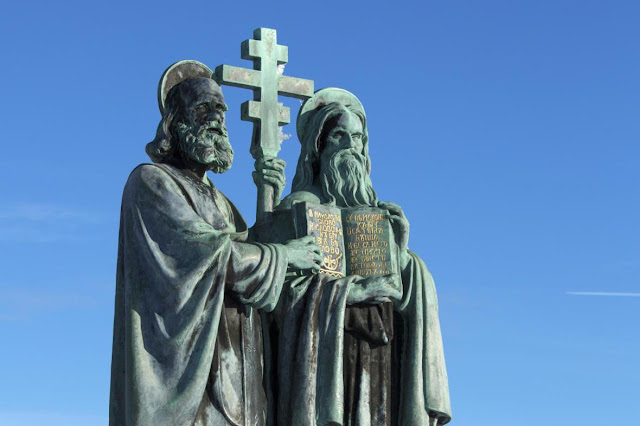Saints Cyril and Methodius Introduced Christianity to Slovakian People

Saints Cyril and Methodius Introduced Christianity to Slovakian People
Saints Cyril and Methodius inspired a profound transformation by introducing Christianity to the Slovak people, paving the way for hope, unity, and a shared cultural heritage. Their mission not only introduced spiritual beliefs but also fostered a deeper sense of identity and unity among the Slovaks.
Christian Mission As Key Figure
Cyril, born Constantine (826–869), and his brother Methodius (815–885) were distinguished Byzantine Christian scholars and educators whose profound contributions to the evangelization of the Slavic peoples earned them the revered title of “Witnesses to the Slavs.”
These two remarkable siblings are renowned for their innovative creation of the Glagolitic alphabet, a groundbreaking writing system specifically designed to facilitate the translation of Old Church Slavonic. Their efforts not only helped to spread Christianity among the Slavs but also laid the foundation for Slavic literacy and culture. After their passing, their dedicated disciples continued the important work of spreading the Christian faith throughout various Slavic regions, ensuring that their legacy would endure.
Both Cyril and Methodius are venerated in the Orthodox Church and are honored with the title of “equivalent to-messengers,” highlighting their status as key figures in the history of Christian missions. Their influence extends beyond the Orthodox tradition; in 1880, Pope Leo XIII embraced their contributions by instituting their feast day in the Roman Catholic Church calendar. Additionally, in 1980, Pope John Paul II proclaimed them co-patron saints of Europe alongside Benedict of Nursia, recognizing their crucial role in shaping the spiritual and cultural landscape of the continent.
Mission to the Great Moravia
Ancient mining apparatuses discovered in the region of Špania Dolina have been dated as early as 2000-1700 BC, indicating the area’s long-standing significance in the extraction of minerals. Archaeological studies have revealed that copper sourced from Špania Dolina can also be traced in bronze artifacts found as far away as the Balkans and the Middle East. This evidence suggests that the local mines were integral components of a vast network of trade routes during the Bronze Age, facilitating the exchange of materials and goods across different cultures and regions.
However, the first documented mention of Špania Dolina appeared much later, in 1254, highlighting its relatively recent acknowledgment in written history. The rich deposits of copper and silver in the area attracted miners from the nearby city of Banská Bystrica. This resource allure was further amplified after 1494 when one of the first international mining partnerships was established, led by the affluent Fugger and Thurzo families. Their involvement catalyzed a mining boom in the region, drawing a multitude of foreign visitors and investors eager to partake in the wealth generated by the lucrative mineral deposits.
The Fugger family notably sponsored a laboratory for the renowned alchemist Paracelsus, showcasing their commitment to the advancement of science and mining technology. The prominent French philosopher Montesquieu later visited Špania Dolina and documented his observations about the copper mines, prompted by Isaac Newton’s interest in the region. This connection emphasizes the significance of Špania Dolina beyond mere mining, as it was intertwined with notable figures in the history of science and philosophy.
First Script For Slavic Language
In the year 862, a pivotal moment marked the beginning of significant historical contributions made by the siblings Cyril and Methodius, who would later be recognized as the “Apostles of the Slavs.” The context of their mission began when Prince Rastislav of Great Moravia, seeking to establish and affirm the autonomy of his realm from Frankish influence, reached out to Emperor Michael III of the Byzantine Empire. Rastislav’s motivations for seeking assistance were likely influenced by political aspirations rather than purely religious intentions. Having been granted his title with the support of Louis the German, the Frankish ruler, Rastislav desired to consolidate his power and foster a distinct Moravian identity, leading him to seek clerical support from the Eastern Church.
It is a common misconception that Cyril and Methodius were the first individuals to propagate Christianity in Moravia. In fact, historical records, particularly a letter from Rastislav to Michael III, clearly indicate that the Moravians had already abandoned paganism and had begun to embrace Christian teachings. Rastislav, disenchanted with the evangelistic efforts from the Roman Church, decided to pursue clerical mentorship from Constantinople, believing that this approach would not only facilitate the promotion of Christianity but also provide him with political backing. In response to Rastislav’s request, Emperor Michael III promptly dispatched the brothers Cyril and Methodius to Great Moravia, recognizing an opportunity to extend Byzantine influence in the region.
Biblical Testament and the Psalms Text
Although the specifics of the biblical texts they translated remain somewhat elusive, it is generally accepted that they began with the New Testament and the Psalms, before moving on to other portions of the Old Testament. Historical references, such as the “Translatio,” mention Cyril’s translation of the Gospels, while “Vita Methodii” talks about the “Evangelium Slovenicum,” suggesting that these early translations played a foundational role in Slavic Christianity. However, it is less clear which liturgical tradition they drew from—whether they primarily utilized the Roman or Constantinopolitan liturgies. Some scholars posit that they may have incorporated elements from the Roman tradition, as supported by liturgical fragments from the “Prague Fragments” and other Old Glagolitic texts preserved in Jerusalem and later discovered in Kyiv by Izmail Sreznevsky. These fragments are notably aligned with the Latin liturgical form, featuring terms like “Mass,” “Prelude,” and names such as Felicitas.
Ultimately, the challenges Cyril and Methodius faced in their mission underscored the necessity for them to seek the approval and recognition of Rome. Without this ecclesiastical endorsement, the enduring success of their efforts in developing a Slavic Christian tradition would have remained uncertain.

“SUPERPOBYT”, “SUPERPOBYT TRAVEL”, and “SUPERPOBYT WORLD” are active service trademarks established by the creators of “UNIWEBSITE SOLUTION”. These services are integrated and linked with the marketing initiatives of “U PRO MARKETER”, forming part of a wider network of services provided under “U FOUNDER World”. This integration enables the creation of a global business network.
The services offered are backed by legally registered businesses, specifically “DEMDERAW PRO LTD” and “UNISOL SLOVAKIA sro.”, with all rights strongly reserved for both entities.
Our operational services are organized into two strategic zones and respective countries, with each company dedicated to providing customized services to the public. We are committed to enhancing travel services and facilitating online travel, allowing customers to easily access travel information and make reservations from the comfort of their own homes.




